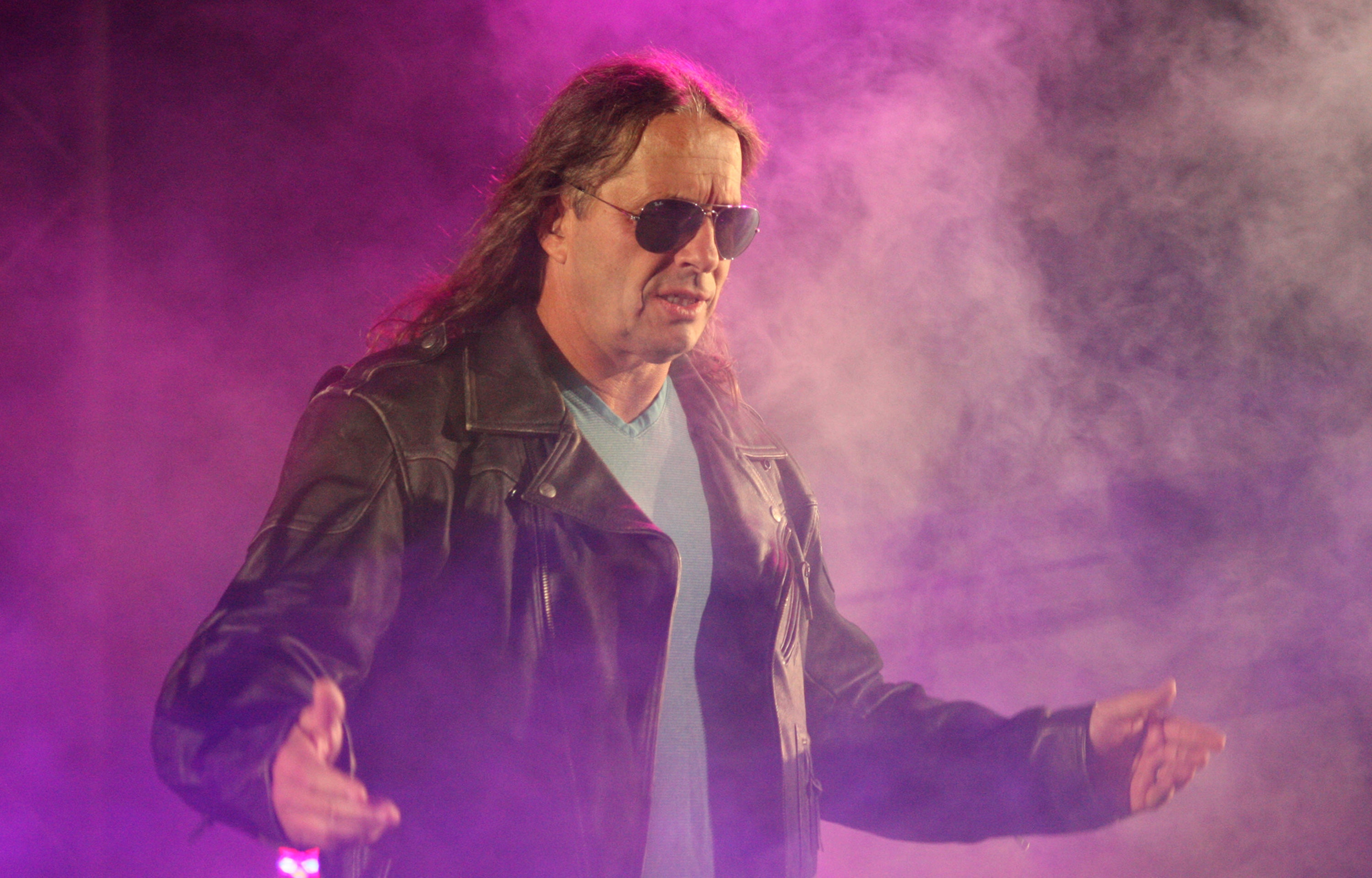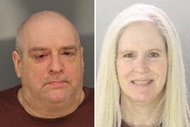Create a free profile to get unlimited access to exclusive videos, breaking news, sweepstakes, and more!
Who Is Bret Hart? The Sports Legend's Controversial Career Changed Wrestling
Bret Hart's legendary wrestling career has been marked by several high-profile controversies, the most notable of which is the subject of an episode of Vice's newest docu-series, "Dark Side of the Ring."

Wrestling fans know their favorite sport is “fake” — but what happens when suddenly, it gets too real? What people outside the industry may not understand is that while the results of matches are pre-determined to create a narrative, what often actually happens during a match is far more authentic than what many perceive.
This bizarre paradigm has plagued legendary pro-wrestler Bret Hart throughout his career. Even if wrestling isn't "real," nothing could be more legitimate than his legacy. Equally as known for his hard-hitting fighting style as he was for the controversies his career sparked, the biggest scandal of Hart's life is now the subject of Viceland's docu-series "The Dark Side of the Ring."
Hart was born into the wrestling industry: The son of Stu Hart, a pre-World Wrestling Federation icon, Hart was raised in Calgary, Alberta, learning the art of grappling throughout his childhood. Both he and his brother Owen rose to incredible heights of fame as wrestling became a cultural phenomenon in the 1980s. But Owen and Hart (and their five other brothers) started as regular characters in their father's independent federation, Stampede Wrestling, according to wrestling historian David Shoemaker in the book "The Squared Circle: Life, Death, And Professional Wrestling."
From the start, Hart was thought of as less likely to succeed as a heavyweight: "Nobody would have predicted his future," writes Shoemaker, "as he was several inches too short and several degrees too plain to compare to the likes of Hulk Hogan or Randy Savage."
Then, Stampede Wrestling was ultimately bought up by Vince McMahon in 1984 during his quest to control all the major independent wrestling companies in the United States.
Hart started to make a name for himself within McMahon's company: He had been raised up alongside Jim “The Anvil” Neidhart as two of the most regularly featured protagonists within the company, immediately ascending to the top ranks of the newly blossoming mega-corporation.
Hart's in-ring style of this era is consistently praised by wrestling performers of several generations.
New York-based pro-wrestler Mik Drake, who considers Hart a major influence on his own career, explains Hart's appeal.
"Bret was kind of a hybrid between the larger than life characters of the '80s and the more reality-based characters that would come later on," Drake told Oxygen.com. "So we'd get these bright pink outfits, but also get a more action-oriented style in the ring that was still based in reality — and that balance is something that inspired me and something that I have always tried to emulate and build into what I do. He was a real person, a character with values and he wasn't a king or telling you to take your vitamins or to say your prayers, he was kind of blue collar in a 'just always do your best and don't give up' sort of way."
Ex-indie wrestler and promoter Nat Peterson concurs.
"In my mind, what made Bret great was his crispness of execution," Peterson told Oxygen.com. "He put a little extra 'snap' into all of his offensive moves, while still being safe. This is what made him stick out to the average fan, despite not being a strong personality in the day-glo '80s and '90s. From a 'worker's' point of view, he had a gift for telling a great story in the ring, and for making any opponent look like a million bucks. He played to their strengths, covered their weaknesses, and made matches seem more epic."
But in one of the most historic moments in the industry, all the rules about what is or isn't real about wrestling were thrown out the window. The bizarre confluence of events that led to Bret “The Hitman” Hart losing his title at the Survivor Series Pay Per View in 1997 have become known as “The Montreal Screwjob,” and to this day is still one of the most shocking incidents in the history of the industry.
A pretty-boy wrestler with luscious golden locks and inexorable sex appeal named Shawn Michaels had been ascending to the highest positions in the WWF parallel to Hart. Hart and Michaels became opponents of mythic proportions, with the showboating narcissist Michaels playing a dangerous rival for the more straight-shooting Hart.
It's Vince McMahon who ultimately chooses the champions of his own company based on his own personal (and highly subjective) criteria. Hart had finally won the WWF Heavyweight Championship after defeating The Undertaker at SummerSlam. Although he was obviously aware that wrestling matches were pre-determined, Hart believed himself to be the rightful and righteous champion.
“I always say I was the real world champion because I really traveled all around the world and defended my belt,” Hart explained in “The Dark Side of the Ring.”
Under pressure from new competition in the form of World Championship Wrestling (which, at that point, had been aiming to steal some of the WWF's audience away with more adult-oriented content), McMahon was forced to think of new ways to attract attention for his events, according to Shoemaker. Meanwhile, Michaels continued to stun crowds with dashing gymnastic performances and unparalleled charisma. McMahon decided Michaels was his new star: McMahon offered Michaels a multi-million contract for decades of loyalty to make sure he would not abscond to another league.
At the same time, the rivalry between Hart and Michaels had crossed over from purely fictional to somewhat real: Hart ribbed Michaels on live TV a bit too hard about his appearance in Playgirl mag, while Michaels poked fun at Hart's alleged trysts with a valet known by the gimmick name Sunny (upsetting Hart's IRL wife). An actual physical brawl — not a staged fight — ensued between the two.
According to "Dark Side of the Ring," Hart was not offered the same kind of contract Michaels was, meaning his departure from the WWF was imminent. Hart was instructed to lose the title to Michaels on his way out of the company, but the animosity between the two had grown too formidable, and Hart refused to be defeated by his nemesis.
Hart explained in the documentary he suspected McMahon would attempt to pay off the referee to end the match in Michaels' favor, knowing Hart's refusal to lose. But referee Earl Hebner says in the documentary that he had close personal ties to Hart and promised that he would do nothing to hurt his friend.
The day of the fight, unbeknownst to McMahon, Hart had been mic'ed up for a documentary called "Wrestling With Shadows" on his last days as a WWF wrestler. In "Wrestling With Shadows," Hart can be heard proposing to simply forfeit the title so he would not have to face a loss. It was ultimately decided, at least to Hart's face, that the match would be ended through a disqualification after other superstars ran in to disrupt the fight.
Simultaneously, Hebner was told to end the match while Hart was placed in his own signature submission hold by Michaels, thus forcing a loss upon Hart. Hart alleges he spotted McMahon demanding the match end at precisely the moment Michaels placed him in his own hold. Hart can be seen reversing the move, but it was too late: The bell had rung. Hart felt betrayed and spat in McMahon's face — for real, not as a story line — before smashing the company's technical equipment in a blind rage.
“It was a couple of guys that couldn't get along. They hit on the most talked-about match ending in the history of professional wrestling since the dawn of time,” says controversial wrestling personality Jim Cornette in “Dark Side of the Ring.”
Various WWF executives, writers, and personalities including writer Vince Russo and Cornette himself, have taken credit (both with reluctance and with pride) for inspiring the double-cross. In the new docu-series, both claim to have whispered the idea into Vince's ear shortly before the event. Others say the whole thing was Hebner's fault. But because of the culture around pro-wrestling, in which discussing what parts of a match are “real” or “fake” is highly taboo, the public may never know the reality of the situation.
Similarly, it remains unclear (to this day!) if Michaels himself was aware of McMahon's intentions at the time of the match. Some wrestling fans and some wrestlers even believe the entire story around the screwjob being a screwjob was entirely fabricated and that the whole thing (including the fall-out) was scripted. The specifics about the event have been scrutinized in immense detail, spawning a Radiolab podcast and several documentaries.
In “Dark Side of the Ring,” Hart claimed that the vitriol he felt for McMahon right after the match boiled over into yet another real backstage altercation between the two.
“I finish showering," Hart said. "I come out. It's funny 'cause I remember coming out of the shower, sopping wet. Naked. I remember Vince says something to me along the lines of, 'This is the first time I ever had to lie to one of my talent,' which is such a lie. I remember tying my shoes. I remember tying my last shoe lace thinking, 'This is it. I'm going to punch out Vince McMahon.' We walked towards each other and ended up tying up, just like a pro-wrestling match. I remember just sinking down and just turning my whole body and thinking, '14 years, right between our arms.' And I hit Vince McMahon with the most beautiful Mike Tyson uppercut. I popped him literally right off the ground. He went straight down. Out cold.”
Since no police report was filed about the attack, the reality of this fight remains unknown.
Knowing Hart's respect for the industry and the code of honor wrestlers take with regards to preserving the secrets of the art form, McMahon bet on him never discussing the backstage politics that led to his loss in public. But Hart's pride was too bruised: He went public with what happened, prompting a response from McMahon, who managed to turn the whole altercation into a publicity stunt. It was at this point that McMahon became even more of a prominent character in his own company, who (in the storyline) was often looking to screw his beloved talent out of opportunities.
"When Vince appeared the night after the Screwjob to plaintively explain what had transpired the night before, he might as well have said, 'It was me all along!' because that, more than the watered-down details of the fracas with Bret, was the real reveal," writes Shoemaker.
The Montreal Screwjob's impact on the industry was indelible. Suddenly, fans were as interested in the backstage politics of wrestling as they were in wrestling itself, catalyzing a newfound complexity in the way wrestling was both packaged as a product and written as a narrative. Wrestling storylines often call back to this event by involving producers, referees, and even writers as key players in what happens during certain matches.
Evan Husney, the producer of "Dark Side of the Ring" talked to Oxygen.com about the enduring appeal of the politics of "reality" within wrestling, as highlighted by the Screwjob.
"This is a world where that area is very gray," Husney said. "And that's what was really appealing to us. We weren't just trying to separate fact from fiction — we weren't literally in the pursuit of truth. It's more about trying to just play in that gray area. We're trying to show you how that gray area is unique and singular to wrestling."
After the infamous incident, Hart made a tepid entrance into WCW, at first as a guest referee, then as a star. He would win the WCW Heavyweight Championship a total of four times during his stint in that company, according to Wrestling-Titles.com. Hart grappled with controversial legends like Hulk Hogan and Chris Benoit (the latter of whom would go on to kill his wife and son in a highly publicized murder-suicide) during his run in that brand.
On May 23 1999, his brother Owen passed away in a freak accident during a live performance. While being lowered into the ring via a harness from the rafters as a dramatic stunt, a technical malfunction caused Owen to plummet 78 feet to the ground, killing him almost instantly. The wrestling world mourned this tragic and entirely unexpected loss. Hart would take four months off from WCW to spend time with his family.
By the time Hart returned to WCW, the luster of the previously hyped-up company had begun to dull, according to The Bleacher Report. Absurd story lines were heavily criticized by performers and fans alike. Hart was forced to vacate the title due to injuries and left the brand shortly thereafter. He appeared briefly as a commentator on a much smaller independent federation after that, but suffered a stroke in 2001, making that job monumentally difficult, according to the Canadian Broadcasting Corporation.
Nonetheless, Hart returned to McMahon's company (which had since been renamed WWE) in 2005. What Hart felt in real life about coming back to the world's biggest wrestling company is unknown, but writers played with his hatred of McMahon throughout several storylines from 2009 and 2010. After his contract expired as those storylines closed out, Hart would only briefly show up for other special events. His most recent appearance included a quick role in the women's tag team title match at Wrestlemania 35 this year, sending off Natalya (the daughter of his former tag team partner Jim Neidhart) and Beth Phoenix to the ring as a show of goodwill.
It's hard to summarize the impact Hart has had on the wrestling industry writ large. Countless current prominent wrestlers cite him as a major influence on their own careers, and the world's most esteemed wrestling critics rank him has the best of the best. Despite his uneasy history with the McMahons, Hart was inducted into the WWE Hall of Fame twice: once as a solo entrant in 2006 and again as a member of his stable, the Hart Foundation, in 2019.
(It does nothing to diminish his status as a hero of mythic proportions, but a strange incident in which a fan rushed the stage at Barclays Center in Brooklyn, New York to attack Hart somewhat marred his second induction. During the ceremony on April 4, Hart was tackled by a bizarre assailant whose motivations remain entirely unclear. The fan was fought off by security guards and several current WWE personnel, including wrestler Dash Wilder.)
Hart is now 61 years old and has officially retired from in-ring action. He has continued to battle a series of health problems, including a scare with prostate cancer in 2016, which he had announced on his Facebook page, according to The Wrestling Observer. Hart clarified that although he was not technically cancer-free, doctors remained optimistic about his prognosis later that year, according to the CBC.
And although we will never see him wrestling again, his legacy and legend has been firmly cemented throughout the industry.

























